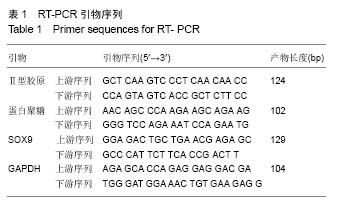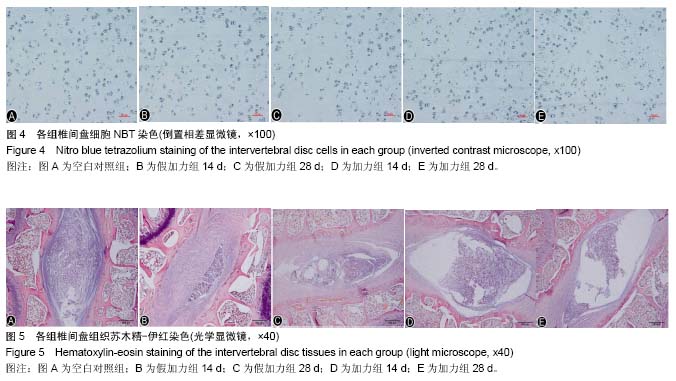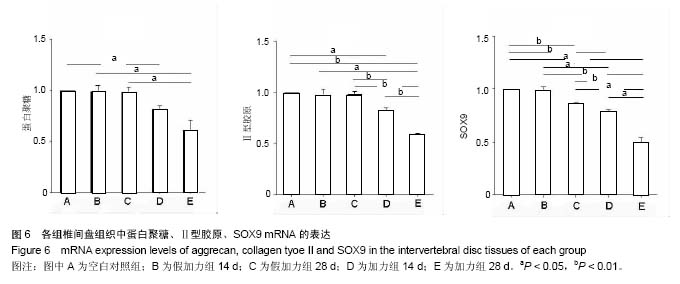| [1] Manek NJ, MacGregor AJ. Epidemiology of back disorders: prevalence, risk factors, and prognosis. Curr Opin Rheumatol. 2005;17(2): 134-140.[2] Ariga K, Yonenobu K, Nakase T, et al. Mechanical stress-induced apoptosis of endplate chondrocytes in organ-cultured mouse intervertebral discs: an ex vivo study. Spine (Phila Pa 1976). 2003;28(14): 1528-1533.[3] Grad S, Eglin D, Alini M, et al. Physical stimulation of chondrogenic cells in vitro: a review. Clin Orthop Relat Res. 2011;469(10): 2764-2772.[4] Guehring T, Nerlich A, Kroeber M, et al. Sensitivity of notochordal disc cells to mechanical loading: an experimental animal study. Eur Spine J. 2010;19(1): 113-121.[5] Kroeber MW, Unglaub F, Wang H, et al. New in vivo animal model to create intervertebral disc degeneration and to investigate the effects of therapeutic strategies to stimulate disc regeneration. Spine (Phila Pa 1976). 2002;27(23): 2684-2690.[6] Wang D, Vo NV, Sowa GA, et al. Bupivacaine decreases cell viability and matrix protein synthesis in an intervertebral disc organ model system. Spine J. 2011;11(2): 139-146.[7] Seol D, Choe H, Ramakrishnan PS, et al. Organ culture stability of the intervertebral disc: rat versus rabbit. J Orthop Res. 2013;31(6): 838-846.[8] Huang KY, Yan JJ, Hsieh CC, et al. The in vivo biological effects of intradiscal recombinant human bone morphogenetic protein-2 on the injured intervertebral disc: an animal experiment. Spine (Phila Pa 1976). 2007;32(11): 1174-1180.[9] Miyamoto K, Masuda K, Kim JG, et al. Intradiscal injections of osteogenic protein-1 restore the viscoelastic properties of degenerated intervertebral discs. Spine J. 2006;6(6): 692-703.[10] Barbir A, Godburn KE, Michalek AJ, et al. Effects of torsion on intervertebral disc gene expression and biomechanics, using a rat tail model. Spine (Phila Pa 1976). 2011;36(8): 607-614.[11] Alini M, Eisenstein SM, Ito K, et al. Are animal models useful for studying human disc disorders/degeneration? Eur Spine J. 2008;17(1): 2-19.[12] Ahn J, Park EM, Kim BJ, et al. Transplantation of human Wharton's jelly-derived mesenchymal stem cells highly expressing TGFbeta receptors in a rabbit model of disc degeneration. Stem Cell Res Ther. 2015;6:190.[13] Kwon YJ. A minimally invasive rabbit model of progressive and reproducible disc degeneration confirmed by radiology, gene expression, and histology. J Korean Neurosurg Soc. 2013;53(6): 323-330.[14] Kim DW, Chun HJ, Lee SK. Percutaneous Needle Puncture Technique to Create a Rabbit Model with Traumatic Degenerative Disk Disease. World Neurosurg. 2015;84(2): 438-445.[15] Adams MA, Freeman BJ, Morrison HP, et al. Mechanical initiation of intervertebral disc degeneration. Spine (Phila Pa 1976). 2000;25(13): 1625-1636.[16] Onodera K, Takahashi I, Sasano Y, et al. Stepwise mechanical stretching inhibits chondrogenesis through cell-matrix adhesion mediated by integrins in embryonic rat limb-bud mesenchymal cells. Eur J Cell Biol. 2005;84(1): 45-58.[17] Xu HG, Zhang XH, Wang H, et al. Intermittent Cyclic Mechanical Tension-Induced Calcification and downregulation of ankh gene expression of end plate chondrocytes. Spine (Phila Pa 1976). 2012;37(14): 1192-1197.[18] Xu HG, Hu CJ, Wang H, et al. Effects of mechanical strain on ANK, ENPP1 and TGF-beta1 expression in rat endplate chondrocytes in vitro. Mol Med Rep. 2011;4(5): 831-835.[19] Rodriguez AG, Rodriguez-Soto AE, Burghardt AJ, et al. Morphology of the human vertebral endplate. J Orthop Res. 2012;30(2): 280-287.[20] Bian Q, Liang QQ, Hou W, et al. Prolonged and repeated upright posture promotes bone formation in rat lumbar vertebrae. Spine (Phila Pa 1976). 2011;36(6): E380-387.[21] He G, Xinghua Z. The numerical simulation of osteophyte formation on the edge of the vertebral body using quantitative bone remodeling theory. Joint Bone Spine. 2006;73(1): 95-101.[22] Xia DD, Lin SL, Wang XY, et al. Effects of shear force on intervertebral disc: an in vivo rabbit study. Eur Spine J. 2015; 24(8): 1711-1719. [23] O'Connell GD, Malhotra NR, Vresilovic EJ, et al. The effect of nucleotomy and the dependence of degeneration of human intervertebral disc strain in axial compression.Spine (Phila Pa 1976). 2011;36(21):1765-1771. [24] O'Connell GD, Vresilovic EJ, Elliott DM. Human intervertebral disc internal strain in compression: the effect of disc region, loading position, and degeneration. J Orthop Res. 2011;29(4): 547-555. [25] Slusarewicz P, Zhu K, Kirking B, et al. Optimization of protein crosslinking formulations for the treatment of degenerative disc disease. Spine (Phila Pa 1976). 2011;36(1):E7-13. |
.jpg) 文题释义:
动物椎间盘加力器:本课题组所采用的兔体内椎间盘加力器是参照国外学者提出的体内加力器设计理念下自主设计的,加力器大小符合实验动物的脊柱大小,并且可以通过对两只螺母的滑动调节,来改变作用力的方向和大小。本加力器具有国家实用新型专利,专利号为:201120575941.X。
椎间盘退变模型:主要包括体外细胞模型、整体器官模型和体内动物模型。体外细胞模型操作容易,数据结果较精确,但是培养的细胞没有正常细胞所拥有的细胞外基质,而整体器官模型虽保留了器官功能单位,但其所处的培养环境已不能等同于正常机体内部微环境,且容易发生污染,因此从某种程度上来说它们都存在着一定的缺陷。对于椎间盘退变相关机制的研究而言,体内动物模型的建立是至关重要的。
文题释义:
动物椎间盘加力器:本课题组所采用的兔体内椎间盘加力器是参照国外学者提出的体内加力器设计理念下自主设计的,加力器大小符合实验动物的脊柱大小,并且可以通过对两只螺母的滑动调节,来改变作用力的方向和大小。本加力器具有国家实用新型专利,专利号为:201120575941.X。
椎间盘退变模型:主要包括体外细胞模型、整体器官模型和体内动物模型。体外细胞模型操作容易,数据结果较精确,但是培养的细胞没有正常细胞所拥有的细胞外基质,而整体器官模型虽保留了器官功能单位,但其所处的培养环境已不能等同于正常机体内部微环境,且容易发生污染,因此从某种程度上来说它们都存在着一定的缺陷。对于椎间盘退变相关机制的研究而言,体内动物模型的建立是至关重要的。.jpg) 文题释义:
动物椎间盘加力器:本课题组所采用的兔体内椎间盘加力器是参照国外学者提出的体内加力器设计理念下自主设计的,加力器大小符合实验动物的脊柱大小,并且可以通过对两只螺母的滑动调节,来改变作用力的方向和大小。本加力器具有国家实用新型专利,专利号为:201120575941.X。
椎间盘退变模型:主要包括体外细胞模型、整体器官模型和体内动物模型。体外细胞模型操作容易,数据结果较精确,但是培养的细胞没有正常细胞所拥有的细胞外基质,而整体器官模型虽保留了器官功能单位,但其所处的培养环境已不能等同于正常机体内部微环境,且容易发生污染,因此从某种程度上来说它们都存在着一定的缺陷。对于椎间盘退变相关机制的研究而言,体内动物模型的建立是至关重要的。
文题释义:
动物椎间盘加力器:本课题组所采用的兔体内椎间盘加力器是参照国外学者提出的体内加力器设计理念下自主设计的,加力器大小符合实验动物的脊柱大小,并且可以通过对两只螺母的滑动调节,来改变作用力的方向和大小。本加力器具有国家实用新型专利,专利号为:201120575941.X。
椎间盘退变模型:主要包括体外细胞模型、整体器官模型和体内动物模型。体外细胞模型操作容易,数据结果较精确,但是培养的细胞没有正常细胞所拥有的细胞外基质,而整体器官模型虽保留了器官功能单位,但其所处的培养环境已不能等同于正常机体内部微环境,且容易发生污染,因此从某种程度上来说它们都存在着一定的缺陷。对于椎间盘退变相关机制的研究而言,体内动物模型的建立是至关重要的。


.jpg)
.jpg)
.jpg) 文题释义:
动物椎间盘加力器:本课题组所采用的兔体内椎间盘加力器是参照国外学者提出的体内加力器设计理念下自主设计的,加力器大小符合实验动物的脊柱大小,并且可以通过对两只螺母的滑动调节,来改变作用力的方向和大小。本加力器具有国家实用新型专利,专利号为:201120575941.X。
椎间盘退变模型:主要包括体外细胞模型、整体器官模型和体内动物模型。体外细胞模型操作容易,数据结果较精确,但是培养的细胞没有正常细胞所拥有的细胞外基质,而整体器官模型虽保留了器官功能单位,但其所处的培养环境已不能等同于正常机体内部微环境,且容易发生污染,因此从某种程度上来说它们都存在着一定的缺陷。对于椎间盘退变相关机制的研究而言,体内动物模型的建立是至关重要的。
文题释义:
动物椎间盘加力器:本课题组所采用的兔体内椎间盘加力器是参照国外学者提出的体内加力器设计理念下自主设计的,加力器大小符合实验动物的脊柱大小,并且可以通过对两只螺母的滑动调节,来改变作用力的方向和大小。本加力器具有国家实用新型专利,专利号为:201120575941.X。
椎间盘退变模型:主要包括体外细胞模型、整体器官模型和体内动物模型。体外细胞模型操作容易,数据结果较精确,但是培养的细胞没有正常细胞所拥有的细胞外基质,而整体器官模型虽保留了器官功能单位,但其所处的培养环境已不能等同于正常机体内部微环境,且容易发生污染,因此从某种程度上来说它们都存在着一定的缺陷。对于椎间盘退变相关机制的研究而言,体内动物模型的建立是至关重要的。